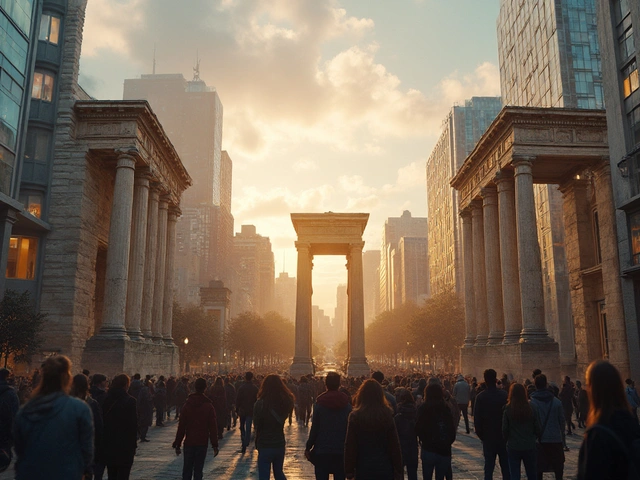Understand The Origin of The Greek Revival Architecture
Now, let me take you on a fascinating journey back in time to ancient Greece. Picture this - a land filled with breathtaking landscapes, beautiful locales, and homes that instantly transport you back to the charm of the ancient world. These homes embody the Greek revival architecture that I find utterly enchanting. Rooted firmly in the artistic traditions of Hellenism, Greek Revival Architecture emerged from the late 18th to the early 19th century, seeking to revive the beauty of classical Greek architectural designs. This architectural genre was truly the epitome of elegance. In order to fully comprehend this style, we must delve deeper into its roots. Interestingly, this architectural revival was propelled by archaeological discoveries that had architects running helter-skelter to recreate the Ancient Greek aesthetic. In fact, Thomas Jefferson, one of the United States presidents, was a strong advocate of this style and made it immensely popular in his country. Let that fact sink in - how about a politician advocating for architectural styles? That's some food for thought!
The Defining Characteristics of Greek Revival Architecture
Every architectural style shines brightly owing to its unique features, and Greek Revival Architecture is no exception. The highlight of the structures within this style involves an abundance of heavy stone or stucco, bold but simple moldings, front-gabled roofs, and, get this - impressive columns! Oh yes, those classic, towering Doric, Ionic, or Corinthian columns, either fluted or smooth, typically define Greek Revival buildings, making a grand, imposing statement. When I first laid my eyes on these architectural spectacles, they took my breath away. Moreover, the buildings feature deep cornices, bold friezes, and pediments, all adorned with classical motifs such as medallions, masks, and statues. Imagine living in a home with all these features; isn't it like living in a palace? On a lighter note, I wonder if they had to dust all those statues!
Greek Revival Architecture in Public Buildings
Let's take a little detour from homes and venture into public structures. You see, Greek Revival Architecture was not limited to residential buildings; it was spread far and wide across public spaces as well. The popularity of this style was so immense that it became a universal language for civic, religious, and institutional buildings. Like a fashion trend, it soon caught attention globally and was adapted everywhere. Today, many famous public buildings across the world, such as Thomas Jefferson's University of Virginia Rotunda, are prime examples of Greek Revival architecture. Doesn't that make you want to teleport there this instant?
The Influence of Greek Revival Architecture on Modern Designs
Like all good things that leave enduring impacts, Greek Revival Architecture also left a significant mark on modern architectural designs. Trust me when I say, its influence is not just restricted to buildings with a vintage flair! Modern cityscape architects ingeniously implement its features like clean-lined exteriors, classic motifs, stucco facades, and of course, grand columns. Show me a city with modern Greek Revival influences, and I'll show you a place humming with timeless elegance.
Opting for Greek Revival Style in Your Home
If you share my passion for this style and are thinking about bringing a slice of it to your home, I have got you covered. Implementing the Greek Revival style doesn't mean you have to build Colosseum-like structures in your backyard. It can be as simple as incorporating Greek motifs in your décor, adding a column or two at your entrance, or opting for a bold stucco exterior. Now, if you choose to go all out and have the resources for it, why not? After all, who doesn’t want to live like Greek gods and goddesses?
Preserving Greek Revival Architecture
Our journey into the Greek Revival Architecture will be incomplete unless we talk about preserving these architectural gems for future generations. It's important to restore and maintain these historical structures to keep their legacy alive. Imagine cities without their historical buildings; doesn't it seem like a black and white film with no color? Therefore, authorities should take necessary steps for the preservation of these structures, ensuring that they continue to add value to the cultural and aesthetic appeal of our cities.
Appreciating Greek Revival Architecture: A Personal Perspective
The elegance of Greek Revival Architecture captivated me right from my first tryst. A funny, yet wonderful memory from my personal life, that I sometimes like to reflect upon, takes me back to a time when I was so spellbound by a Greek Revival mansion in my hometown Adelaide. I would regularly walk past this majestic mansion, hopelessly obsessed and would often catch myself daydreaming about what it would be like inside, or how it must've been in the times of its glory. It was then, I guess, that I unwittingly fell head over heels for this architectural style. Ever since, I've always looked out for those majestic columns, intricate friezes and grandiose entrances that are quintessential of Greek Revival Architecture, that have an irresistible charm, and transport me back to another era, making me feel as if I'm part of a beautiful, romantic period film. I mean, who wouldn't like that kind of glam, right?





